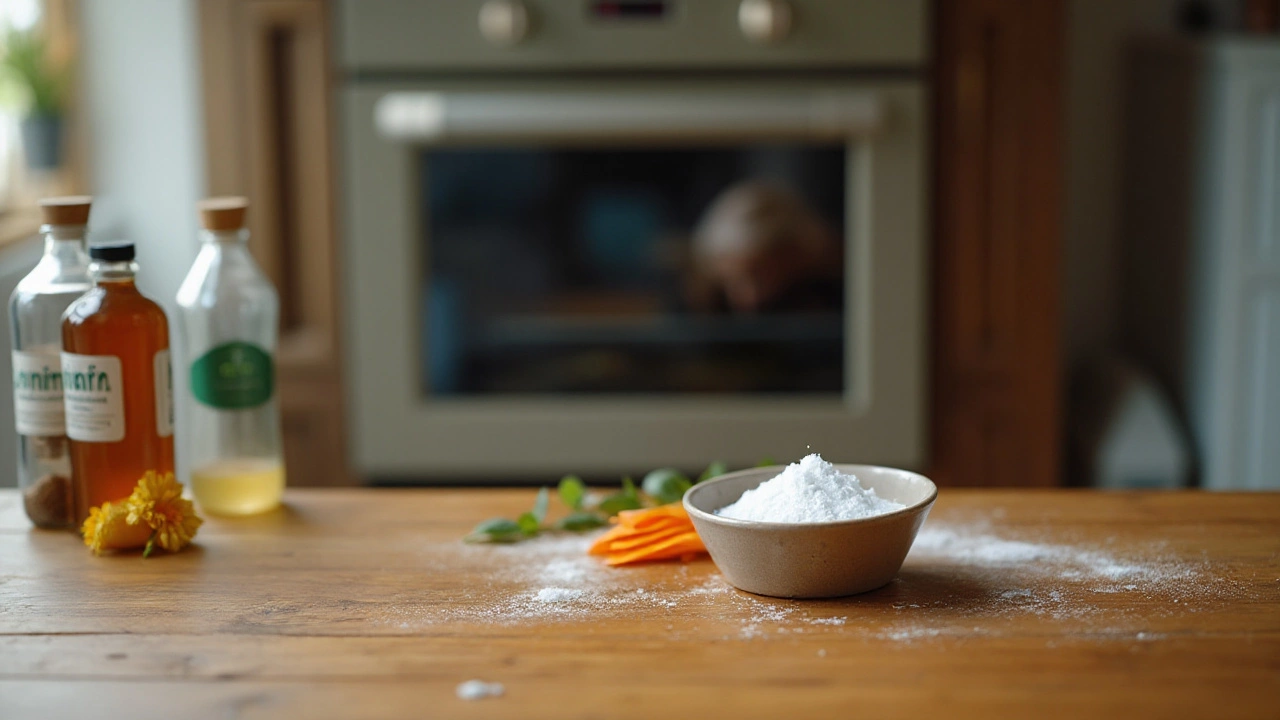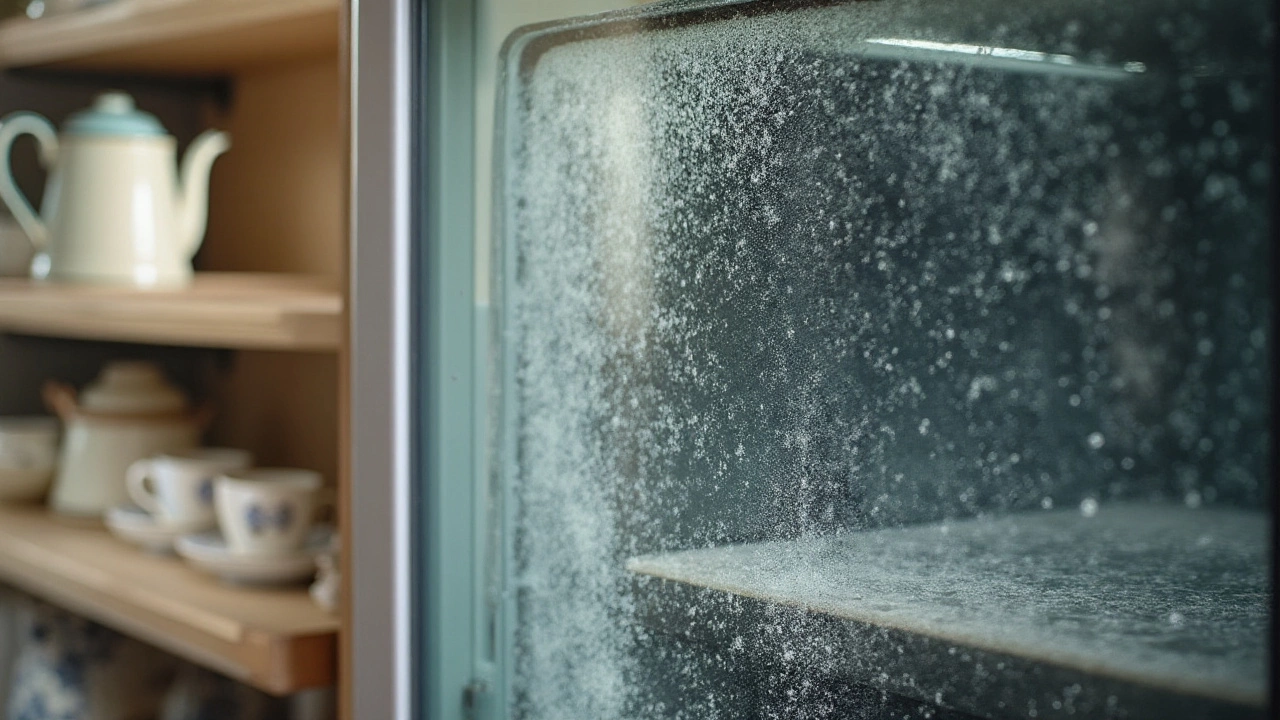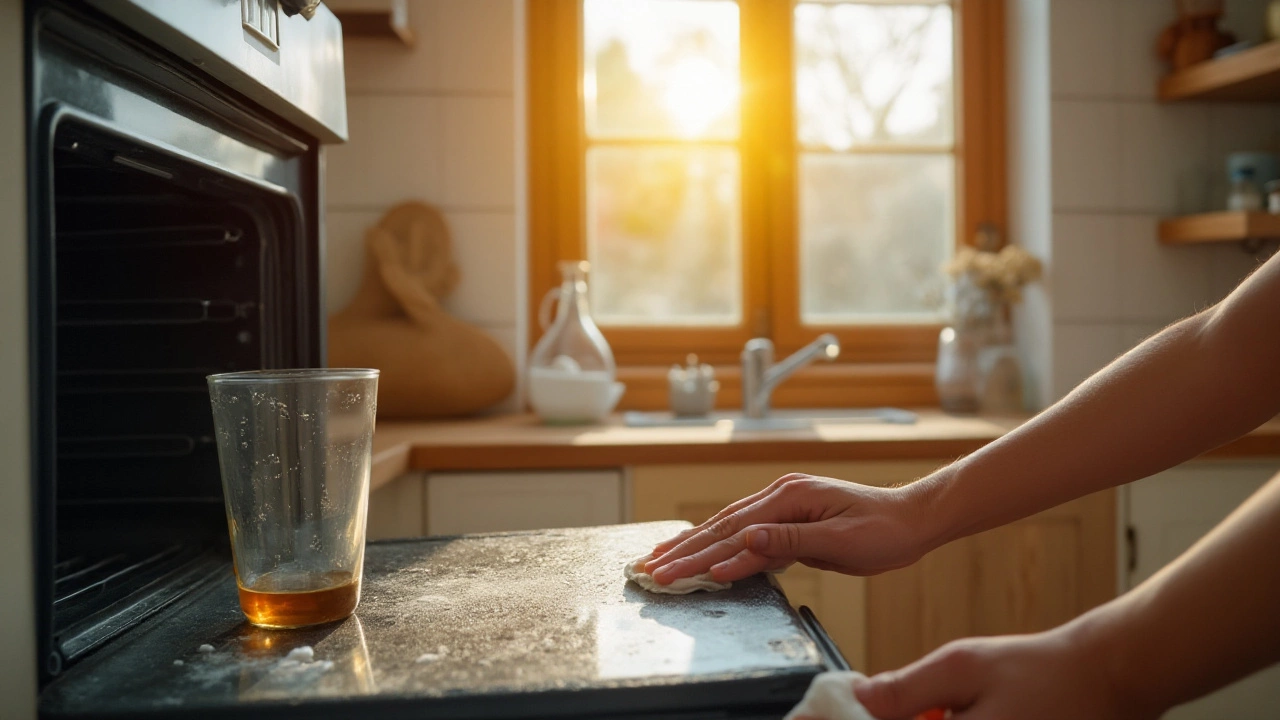Cleaning the oven door glass is a vital yet often neglected task in the kitchen. It seems like no matter how careful you are, grease and food splatters eventually find their way onto the glass, obscuring your view of baking masterpieces. Luckily, nature provides us with simple solutions using common household items like baking soda and vinegar, to bring back that pristine shine.
The journey to a spotless oven is not only about elbow grease but also understanding the materials at hand. Baking soda, a staple in homes, paired with the acidity of vinegar, does more than unclog drains; it can be your ally against the grimiest of kitchen showcases. With a few household approaches, you can keep that window to your cooking world clear and bright.
- Understanding the Components
- The Science Behind Baking Soda and Vinegar
- Step-by-Step Cleaning Guide
- Tips for Optimal Results
- Safety Measures and Considerations
Understanding the Components
When it comes to cleaning, especially in the kitchen, many of us often reach for chemical-laden products out of convenience. However, the magic of natural cleaning agents like baking soda and vinegar cannot be overstated. Let's delve into what makes these common household items so remarkably effective against stubborn grime.
Baking soda, or sodium bicarbonate, is a white crystalline salt found in nature's mineral springs. It's renowned for its non-toxic properties, deodorizing, and mild abrasive characteristics. These make it an ideal cleaning agent that's gentle on surfaces yet tough on dirt. The tiny granules of baking soda act as a scrub, easily removing caked-on food particles without scratching the oven glass. On the other side of the spectrum, we find vinegar, a product of fermented ethanol that transforms sugars into acetic acid. Vinegar, especially white vinegar, is exalted for its acidic nature, which enables it to cut through grease and dissolve mineral build-up effectively. When combined, baking soda and vinegar create a powerful cleaning duo. The fizzing reaction that occurs upon their union is more than just a spectacle; it's an essential action that lifts and loosens dirt and grime with minimal physical effort.
According to Dr. Jennifer H. Meyer, a chemist specializing in household cleaning solutions, "The reaction between baking soda and vinegar is an excellent example of double displacement, where the elements swap places to form carbon dioxide gas and water. This bubbling action dislodges particles, making them easy to wipe away."
Using a combination of these two inexpensive and environmentally friendly products embraces a greener approach to household chores.Such insight helps us appreciate the science behind what might seem like a humble cleaning concoction.
A retrospective view of history reveals that our ancestors might not have had the synthetic cleaners we do today, but they were no strangers to these natural solutions. In the 19th century, people often used baking soda for a myriad of purposes, from baking to medicinal uses. Fast forward to modern times, and it remains a staple in homes worldwide. The same can be said for vinegar, which traces its use back thousands of years, from preserving foods to natural cleaning. A captivating blend of science, history, and tradition gives these odors and stains fighting ingredients enduring popularity in household cleaning.
Qualities of Baking Soda
- Non-toxic and safe around children and pets.
- Mild abrasive, helping to scrub surfaces without damage.
- Deodorizes by neutralizing odors instead of masking them.
Strength of Vinegar
- Acidic nature breaks down grease and mineral deposits.
- Affordable and widely available.
- Antimicrobial properties help to sanitize surfaces.
By understanding these components and how they work, you can see why using baking soda and vinegar for cleaning tasks like maintaining your oven door glass is not only effective but also an intelligent and earth-friendly choice.
The Science Behind Baking Soda and Vinegar
Many people wonder why combining baking soda and vinegar is such a powerhouse for cleaning, especially on surfaces like oven glass. At first glance, they seem like ordinary kitchen items, yet their chemical properties make them exceptional cleaning agents. Baking soda, scientifically known as sodium bicarbonate, is a mild alkali. Its slightly gritty texture aids in scrubbing without being too abrasive, making it ideal for removing stubborn build-up from surfaces. But it's more than just a material solution; it neutralizes odors too, which is why it often sits in refrigerators across the world to combat unwanted smells.
On the other hand, vinegar is acetic acid, which explains its sharp smell and taste. This diluted acetic acid is a brilliant grease-cutter due to its ability to break down organic compounds. When you combine these two, a chemical reaction occurs that releases carbon dioxide gas, which you might notice as fizzing and bubbling. This bubbling action does more than put on a show; it helps physically lift dirt and loosen grime, particularly useful on an oven's glass surfaces that catch all sorts of culinary residues. However, this reaction is short-lived, so using them correctly together can make all the difference.
A study conducted by the Journal of Environmental Health revealed that vinegar's acidic content can remove up to 80% of bacteria and mold present on surfaces. Combining its antibacterial properties with sodium bicarbonate's abrasive quality results in a dynamic cleaning duo. Yet, despite their combined strength, they remain gentle on surfaces, leaving no toxic residues behind. It’s this non-toxic nature that makes many homeowners turn to these natural powerhouses for their cleaning arsenal rather than commercial cleaners loaded with chemicals.
"The combination of baking soda and acetic acid (vinegar) provides an eco-friendly option for cleaning because it avoids any potential health risks associated with synthetic compounds," suggests Professor Emily Howard, a notable chemist in surface interactions.
In practical terms, mixing baking soda with a bit of water forms a paste that can easily adhere to vertical surfaces like oven door glass. When spray vinegar over it, the ensuing chemical reaction aids in scraping off food residues effectively without requiring harsh scrubbing. It's this versatility that allows both materials to stand out as cleaning agents. Their easy availability makes them a go-to solution for people opting for cost-effective, natural cleaning methods. So, while it might seem like magic, it’s pure, simple science offering answers sourced right from your kitchen cabinet.

Step-by-Step Cleaning Guide
Imagine a sparkling oven door glass that lets you peek directly into the heart of your culinary creations. Achieving that spotless clarity is easier than you might think, thanks to the power of everyday items like baking soda and vinegar. Begin by gathering your materials: baking soda, white vinegar, a spray bottle, a microfiber cloth, and a spatula for scraping off stubborn bits. Before the actual cleaning begins, it’s essential to make sure the oven is completely cool. Not only is this for your safety, but it also ensures the cleaning agents work more effectively without burning off prematurely.
The first step is to create a thick paste using one part water and three parts baking soda. Spread this paste liberally over the interior of the glass. Cover all the spots where grime or food residue have secured a foothold. Let this remarkable mixture sit for at least 15 to 20 minutes. During this time, focus can shift to the vinegar, which is a natural degreaser and disinfectant. Fill a spray bottle with white vinegar and spritz it over the baking soda paste. You’ll notice a fizzing reaction; this is the natural abrasive action that breaks down grime.
This magical fizzing action is the combination of baking soda's alkaline properties reacting with the acidity of vinegar. Allow this chemical reaction to work its magic for another 10 minutes. It’s worth mentioning that, according to experts like Diane Henkler from ‘In My Own Style’, "The trick to effective cleaning is giving these ingredients some time to activate and soften the dirt,"
Diane Henkler, renowned home organization specialist.
Once the solution has had ample time to battle the dirt, it’s time to wipe away the concoction. Use a damp microfiber cloth to wipe down the glass, applying some pressure in circular motions to lift off the grime. For any particularly stubborn spots, a gentle scrape with a spatula or a plastic scraper can do wonders. If residue persists, feel free to repeat these steps. Patience and persistence will yield the clean surface reminiscent of new.
Finish off the cleaning process by giving the glass a second once-over with a damp cloth to remove any residue from the baking soda and vinegar. To ensure gleaming results, dry the glass using a fresh microfiber cloth. Buff the surface in small, circular motions for a streak-free finish. The brilliance returned to your oven door glass will beautifully complement the vividness of your culinary successes, providing both functionality and aesthetic appeal.
Tips for Optimal Results
Cleaning an oven door glass efficiently isn't just about scrubbing till your arms give out. The secret lies in striking a balance between technique and the right tools. To achieve a shimmering oven window, you need to turn the age-old combination of baking soda and vinegar into your trusty cleaning allies. Start by ensuring your oven is completely cool, so it's safe to work on. Pre-cleaning, it's wise to remove any loose debris or crumbs with a dry cloth. This allows the cleaning mixture to concentrate on the more stubborn grime without getting compromised by the initial layer of dirt. Many people don't realize, but success is in the details!
Sourcing the right ingredients can make or break your cleaning adventure. Opt for a pure, food-grade baking soda, which guarantees that there's nothing but the cleaning power you need. As for vinegar, apple cider or white vinegar both do a commendable job, though the former may leave a slight scent if not washed off thoroughly. Mixing the two correctly is vital; the fizzing reaction helps to lift grime, but too much vinegar can result in liquid rather than a paste, which is harder to manage and less effective.
The natural home expert, Bren Did, once said, "The trick to natural cleaning is understanding the role each substance plays and knowing their limits."
Speaking of techniques, patience is your secret weapon. Allowing the baking soda solution to sit on the glass for fifteen to thirty minutes gives it ample time to do its work. Then, gently wipe it down with a damp cloth, persistently but without excessive force, to avoid scratching the surface. Sometimes a second round may be needed for those deeply stubborn spots. Interestingly, a quick swipe with a microfiber towel as a final step can aid in achieving that streak-free shine we all desire.
While many might dive right in with their bare hands, donning a pair of rubber gloves can provide an additional layer of defense against the drying nature of soda and vinegar. Another pro-tip is to use a dedicated sponge or cleaning brush for your oven-cleaning endeavors. It helps keep your other cleaning supplies from becoming intertwined with greasy residues. Lastly, consistency is key. Regular maintenance, maybe once every month or two, drastically reduces the build-up of grime, and your oven glass will always be ready to showcase what’s cooking inside.

Safety Measures and Considerations
Cleaning with baking soda and vinegar is relatively safe, yet understanding the safety measures ensures a hassle-free experience. First off, it's essential to recognize the mild but effective nature of these household items. Unlike industrial cleaners, baking soda and vinegar will not release harsh fumes, making them ideal for indoor cleaning without the need for heavy ventilation. However, it's crucial to keep your workspace ventilated with open windows or a running fan. This helps disperse any vinegar odors and ensures fresh air flow.
When mixing the two together, a chemical reaction creates carbon dioxide, causing a fizzing action. This can be startling if unprepared. It’s this activity that makes the combination effective in lifting dirt and grime. Be cautious of potential residues left behind by baking soda. Ensuring a thorough rinse with a damp cloth can help prevent white streaks post-cleaning.
Always make a patch test on a less visible part of the glass. This practice will help you ascertain that the chemicals do not react negatively with any coatings or materials specific to your oven. And while rare, some old oven models might have specific coatings that react adversely to vinegar. It’s also worth mentioning that after cleaning, avoid using the high heat setting immediately—instead, allow all components to dry naturally. An unintentional reactivation of cleaner residues could result in minor reactions.
Some prefer using only baking soda on older or delicate glasses due to its less abrasive nature. Yet, vinegar is essential for tough grease. Nonetheless, caution should be practiced both ways, gently wiping instead of scrubbing rigorously to avoid scratching the glass. A pair of gloves can protect hands, especially for those with sensitive skin, as prolonged contact with these substances might cause mild irritation for sensitive skin types. Wear gloves made of latex or rubber for the best protection.
According to the U.S. Environmental Protection Agency, using natural cleaning agents mitigates indoor pollution risks often posed by chemical commercial cleansers.For those interested in eco-friendly cleaning, this duo offers both peace of mind and effectiveness. Keep an eye out for any peculiar reactions and understand that patience during the cleaning process leads to cleaner, brighter oven glass surfaces without compromising safety. With these measures in mind, your kitchen will stay not only clean but safe for everyone involved in preparing meals.
